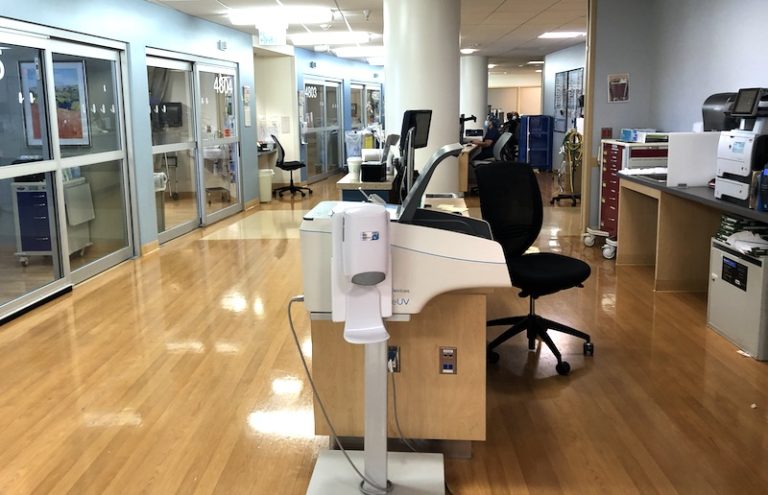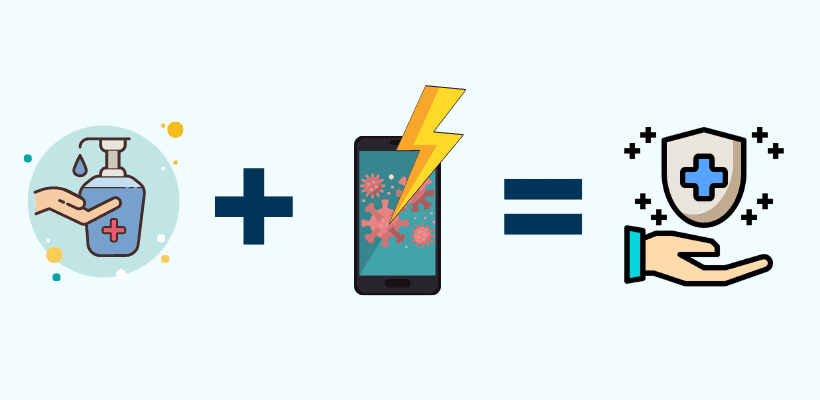Seven years ago, we started CleanSlate UV with one simple goal: to ensure that no one gets sick from the germs on mobile devices.
We decided to focus on mobile devices for two simple reasons:
- They were a rapidly-growing challenge for hospitals. Smartphones, tablets and other devices were set for rapid adoption, but few solutions existed to effectively sanitize them.
- Un-sanitized mobile devices were a major roadblock for a major, ongoing infection control challenge: hand hygiene. Staff and visitors would wash their hands and immediately touch contaminated mobile devices.
With these two things in mind, it should be no surprise that enabling proper hand hygiene has been at the forefront of our product design processes.
From touch-free device removal, to on-screen messaging encouraging users to sanitize hands during the 20 second cycle, there are many small but important ways that hand hygiene is encouraged.
Device Hygiene + Hand Hygiene = Personal Hygiene
Over the past three years, as our hospital and non-hospital deployments have grown, we’ve heard a lot about hand hygiene.
We’ve heard anecdotal evidence of hospitals seeing increased hand hygiene near CleanSlate UV sanitizers.
We’ve seen customers craft their own signage that encourages hand + device hygiene to happen at the same time.
And we’ve seen facilities place CleanSlate UV sanitizers so they align perfectly with hand hygiene choke points.

Now, three years after our first hospital deployment, I’m excited to share a ‘sneak peak’ of data on CleanSlate UV, hand hygiene compliance, and the next step in our mission to make hospitals safer.
Increasing Hand Hygiene Compliance
Since founding CleanSlate, we’ve been lucky to have fantastic hospital innovation partners, from Mt. Sinai NYC to Kingston General Hospital.
This summer, we expanded our partnership with a major Toronto-area hospital to include two new items:
- We deployed more CleanSlate UV sanitizers throughout their facility and;
- We attached IoT sensors to all hand sanitizers within an 80 foot radius of each CleanSlate unit.
The early results from this hand sanitizer sensor deployment was nothing short of spectacular. These initial results have included:
- 54-110% increase in hand hygiene events within a 80 ft radius of the CleanSlate units.
- >250% increase in hand sanitizer usage directly adjacent to the CleanSlate.
- 52% reduction in hand hygiene events when the CleanSlate was removed, proving both a positive and negative correlation between CSUV and hand hygiene.
Within the next two months we will be sharing the full details of this study, along with broader analysis.
But based on the initial results, it’s very clear that we’ve been successful not just in ensuring mobile devices are pathogen-free, but also in creating true personal hygiene events within the hospital.
Additionally, the data and observations from this deployment has validated our focus on the user experience.
These results were achieved using our standard signage and placement methodology – nothing more. No promos, manual auditors, or special signage. The presence of the CleanSlate UV sanitizer itself was the catalyst for these results.
Beyond the Numbers: Why This Matters
One of the most difficult parts of working in a hospital’s Infection Prevention and Control (IPAC) group is implementing interventions without adding steps to the workflow. The more steps you add, the less likely staff, visitors and patients are to follow that guidance.
This is part of what makes the results above so compelling.
As one IPAC member recently said to me: “How often do you get an infection control technology that people actually want to use and will continue to use over time?”.
The answer: it's very rare.
Our team’s focus on a simple user experience; on clear, compelling signage; and on a fast, chemical-free process have all led to a solution that doesn’t just sanitize mobile devices. It encourages a full personal hygiene event.
By showing an increase in hand hygiene, we are also showing that CleanSlate UV deployments can impact one of the most critical variables in preventing the spread of hospital-acquired infections (HAIs).
For a company focused on reducing the spread of pathogens and supporting IPAC professionals, this is a huge step forward.
More Coming Soon...
We are excited to share more details on the technology platforms and partnerships that have made tracking these results possible.
In the next four weeks we will be rolling out a complete intelligent hygiene suite that includes active IoT monitoring of device disinfection; active fleet monitoring; proactive maintenance alerts; usage trend analysis and reports; and much more.
This will be followed by direct outreach to our existing customers and partners on how they can leverage this new data.
Until then, our inbox is always open.
Sincerely,
![]()
Taylor Mann
Co-founder & CEO


